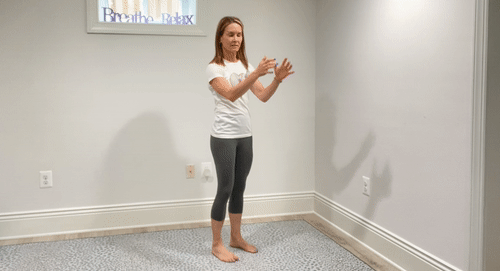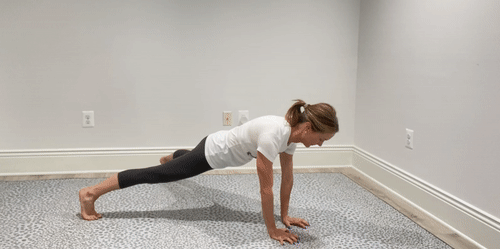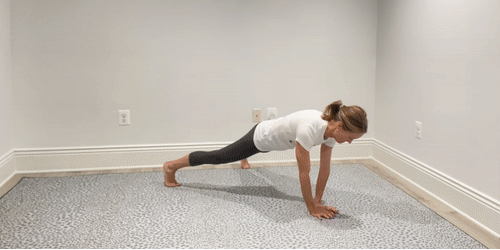We plank all day long. Whether you’re working at a standing desk, sitting in traffic in your car, carrying a heavy box, or kneeling on the floor cleaning your house, you are planking! Everything between your hips and your shoulders forms a straight line – and it is your core. Yes, everything from front to back. The opportunity to “plank” is almost endless. When done properly with a “long spine” and focused core engagement, we are planking.
It’s not news to you that a weak or underutilized core will drastically increase your risk of back pain, injury, and a host of other physical complications from the top of the head to the feet. According to Mayoclinic.com, 80 percent of the American population will have low back pain in their lifetime, and back pain costs $100-200 billion annually to the United States economy, two-thirds being lost wages and productivity.
Back pain causes us to be sidelined from both work and play, with the need for countless doctor’s and specialist’s visits. It also leads to immobility, which then often leads to wellness challenges, including increased anxiety and hunger, and onto serious conditions like depression.
According to the Findings from the Global Burden for Disease Study 2017 by the Institute for Health Metrics and Evaluation, back pain was the #1 leading cause of disability worldwide.
Most troubling for us women, data from the Centers for Disease Control and Prevention (CDC) shows that a greater percentage of women experience lower back pain than men. Those numbers increase with age.
Last, low back pain can lead to less exercise, disrupted sleep, more cravings (from less sleep), and an inability to perform daily tasks. It’s not a pretty picture.
A strong core is so much more than a flat/toned stomach or “6 pack.” It is way more than the aesthetics of the “look.” Our core helps to stabilize our entire body, prevents injury, improves posture, and gives us the ability to strength train without limits. It protects our essential organs and helps to keep the waistline in check with well-documented waist-to-height ratios. It is the difference between falling or not when caught off guard. In sum: it is everything.
Nearly every movement we teach at Alexandria Wellness activates the muscles of the core – squats, deadlifts, pushups, crawling… you name it! Planks are just one way to strengthen our core, yet there are many variations of the plank which target different areas and keep things interesting and fun! And again, we emphasize we are planking all day long – so paying closer attention to posture helps our community keep their strong(her) core.
I have not addressed the “abs are made in the kitchen” belief because that is another blog I’m soon to write. Our food choices are instrumental to our core, for sure, yet most important to our overall health and well-being.
Here are 10 body weight movements to strengthen your core:
1) Standing plank. In a standing position, tuck pelvis, squeeze glutes, pull shoulders down and back, press feet hard into floor, keep neutral spine, and make sure body is aligned from head to toe.

2) Kneeling plank. Place elbows directly under shoulders, knees on the (pressing into) ground, squeeze glutes hard, “pull” hands toward knees to create more tension in midsection.
3) Dying bug. Lay on your back with knees directly above hips and shoulders up off the floor. Slowly lower your opposing limbs (right arm/left leg) down toward the floor, return to starting position, and then repeat on the other side. The goal here is to keep the core engaged (pelvis to ribcage) throughout the entirety of the movement.

4) Hard style plank (on hands). Place hands directly under shoulders, tuck pelvis, keep head up/neutral, pull knees up by squeezing quads and glutes, “pull” hands toward toes to create more tension in midsection.
5) Hard style plank (on elbows). Place elbows directly under shoulders, forearms parallel, head up/neutral, tuck hips, pull knees up by squeezing quads and glutes, “pull” your elbows toward toes to create more tension in midsection while pushing heels back behind you.

6) Shoulder taps. Start in a “tall plan” position, yet with hands close together and feet further apart. Slowly lift one arm and tap your opposite shoulder, keeping your hips steady and parallel with the floor (don’t let them shift!). Then repeat on the other side.

7) Side plank. Place elbow directly under shoulder, keep shoulder down and away from neck by squeezing pit into ribs, pull hips up, so that shoulder to toes is one straight line.
8) Crawl. Start in a quadruped position (hands under hips/knees under hips) with knees hovering over the floor. Use opposing limbs to crawl forward, backward, or side to side. You can learn more about the crawl here.
9) Walking plank. Walk side to side using your opposing limbs (left hand with right foot, right hand with left foot) while keeping plank form the entire time.

10) Hollow hold. Lay flat on your back, and slowly lift feet and shoulders off the ground, keeping lower back pressed to the floor. Arms can hover by your sides. For more of a challenge, you can move arms over/behind head and keep legs straight. A more modified position is to keep a bend to the knees. The lower back MUST remain pressed toward the floor at all times. Check out my hollow hold here.
We want to help you (and your team!) take charge of your health and wellness. Here are two ways you can get started today. If you are interested in any of our newest programs, like our latest special for our small group fitness program, email us at alicia@alexandriawellness.com.



